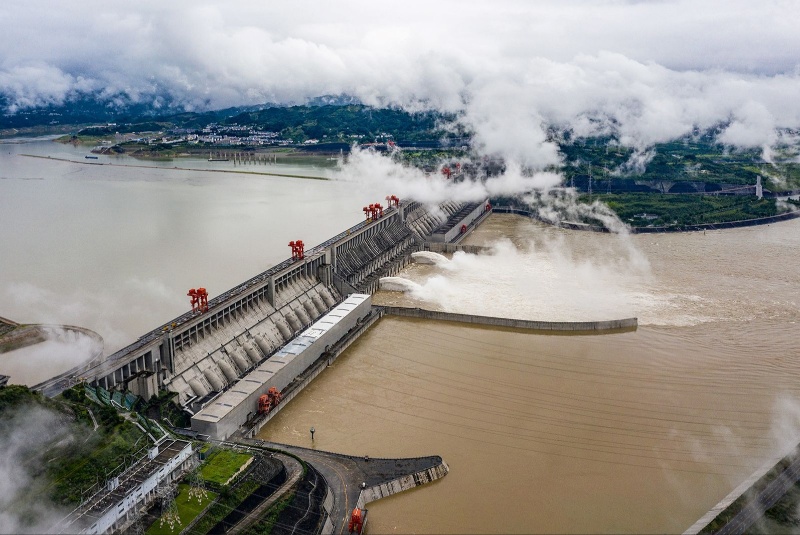The Three Gorges Dam in China is not only a marvel of human engineering but also a testament to humanity's capacity to impact the very dynamics of our planet. This gargantuan structure, which harnesses the waters of the Yangtze River, is emblematic of China's rapid industrial growth and its consequential footprint on the Earth's natural processes.
Before delving into the profound implications of this massive dam, it is essential to comprehend the sheer scale of this project. The Three Gorges Dam is the world's largest power station in terms of installed capacity. With a staggering length of 2,335 meters and a height of 185 meters, the dam's construction has been a polarizing subject across various spectrums—environmental, social, economic, and geopolitical.
The environmental impact is multifaceted. The reservoir created by the Three Gorges Dam is massive, holding about 39.3 trillion kilograms of water above sea level. This body of water, elevated 175 meters from the sea level, exerts a significant amount of pressure on the Earth's crust. It's not merely the presence of this water that's of interest but its dynamic influence on the Earth's rotational velocity that raises both eyebrows and concerns.

To comprehend this influence, one must understand the concept of the moment of inertia, which in simple terms, refers to how mass is distributed relative to an axis of rotation—the farther the mass is from the axis, the greater the moment of inertia, and the slower the object rotates. This principle applies to a range of scenarios, from a figure skater's spin to the Earth's journey through space.
When the Three Gorges Dam was built, it effectively served as a colossal storage space for a massive volume of water. This accumulation of water caused the Earth's moment of inertia to alter ever so minutely. According to NASA's calculations, the redistribution of this weight of water has led to the slowing down of Earth's rotation by an almost imperceptible 0.06 microseconds. While this may seem trivial, it is a significant indication of how human activity can influence the natural balance of the planet.
It is no secret that the Earth's rotation is not constant. It fluctuates due to various factors, ranging from seismic activity to the gravitational effects of the moon. Even the phenomena associated with climate change, such as the melting of polar ice caps, contribute to changes in how our planet spins. Nonetheless, the idea that a single man-made structure could have a measurable impact on the rotation of our planet is nothing short of astounding.
In terms of its intended purposes, the Three Gorges Dam has been lauded for its contributions to hydroelectricity, flood control, and improving navigation along the Yangtze River. The dam's hydroelectric power station is a behemoth in its own right, with the capacity to generate over 100 terawatts of electricity per hour. This tremendous energy output positions the dam as a cornerstone of China's strategy to reduce its reliance on coal and mitigate air pollution.
However, such a massive undertaking has not come without costs. The dam has been at the center of environmental controversy due to the extensive ecological changes it has induced. The impounded water has dramatically altered the landscape, potentially increasing the frequency of landslides and causing significant ecological damage to the river's biodiversity. Moreover, the dam's construction has led to the displacement of millions of individuals, uprooting communities, and submerging numerous cultural and historical sites.
The social implications are as profound as the environmental ones. The displacement caused by the dam's construction has affected over 1.3 million people, forcing them to leave their ancestral homes and relocate. This mass migration has not only disrupted lives but also has profound cultural implications, as entire communities with rich historical backgrounds have been scattered and their ways of life altered irrevocably.
The economic narrative woven around the Three Gorges Dam is also complex. On the one hand, it is a symbol of China's economic might and a source of immense national pride. On the other hand, there is a palpable tension between the economic benefits and the long-term sustainability of such a project. Critics argue that the costs, particularly the potential for catastrophic environmental effects, may outweigh the economic gains in the long run.
Delving deeper into the technicalities, the dam's role as a flood control mechanism cannot be overstated. It is designed to mitigate the impact of potentially devastating floods along the lower reaches of the Yangtze River. By managing the flow of the river, the dam has played a pivotal role in protecting millions of people and a vast amount of farmland from the seasonal ravages that the river can bring.
However, the Three Gorges Dam's influence extends beyond the borders of China. The changes in sediment flow due to the dam have implications for the river's delta and the East China Sea ecosystem. The trapping of sediment behind the dam walls has altered the geomorphology of the river, affecting aquatic habitats and the life cycles of species dependent on the river's natural flow.
The geopolitical aspect is also noteworthy. The dam has served as a statement of China's engineering capabilities and its willingness to undertake massive infrastructure projects. It reflects a broader theme of the rise of China as a global superpower, willing to invest in colossal projects that have far-reaching implications, both domestically and internationally.
In retrospect, the Three Gorges Dam serves as a paragon of human ingenuity and the relentless pursuit of progress. Yet, it also stands as a cautionary tale of the profound responsibilities that come with such power. The narrative of the Three Gorges Dam encompasses a spectrum of human experiences—ingenuity, progress, consequence, and adaptability.
As the dam continues to operate, it remains a subject of intense study and debate. The environmental monitoring and research that surrounds the dam's operation are critical in understanding the long-term implications of such an immense alteration of natural waterways.
The Three Gorges Dam is more than just a structure; it is a focal point for discussions on sustainability, environmental stewardship, and the legacy we leave for future generations. The infinitesimal slowing of Earth's rotation is a metaphor for the broader implications of human actions on our planet's delicate balance. It is a reminder that our capacity to shape the environment is matched by a responsibility to preserve it. The legacy of the Three Gorges Dam is still being written, and its chapters will be studied for decades, if not centuries, to come as a pivotal moment when humanity's reach extended into the very mechanics of the Earth itself.




